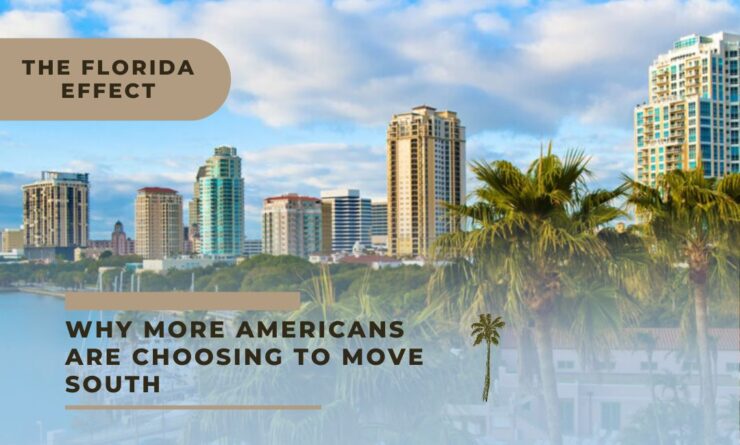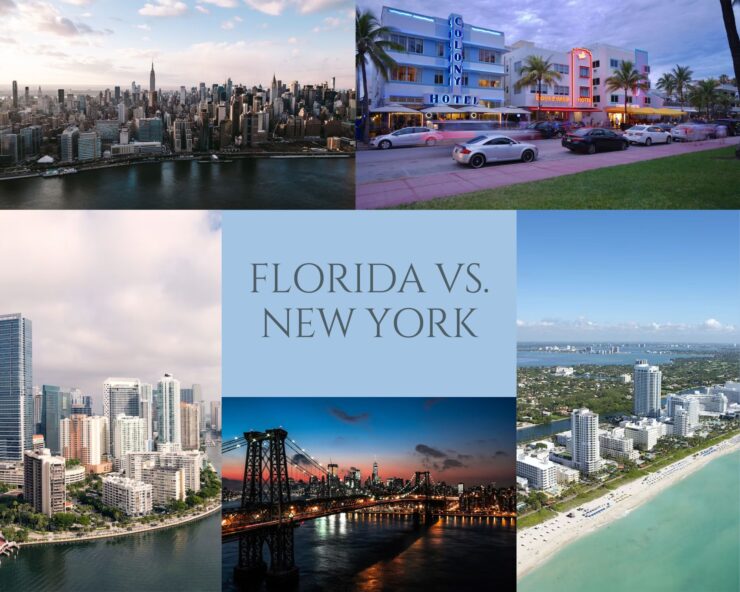A fresh report from the Bureau of Labor Statistics reveals a surprising shift: Florida, often associated with retirees and the elderly, has recently overtaken New York in terms of job numbers — a first since these statistics began to be tracked in 1982.
A significant increase in migration to Florida was recorded from July 2021 to July 2022, with more than 400,000 individuals making the move. This number marked an increase of over 180,000 from the previous year. Moreover, it appears many of these newcomers are not simply there for relaxation.
Table of Contents
ToggleReminder
- A loss of confidence in the stock market has prompted young, affluent Americans to invest in these three assets.
- You have the opportunity to become the landlord of major retailers like Walmart, Whole Foods, and CVS (and generate significant income from these grocery store-anchored properties on a quarterly basis)
- At the end of last year, Florida boasted 9,578,500 non-agricultural jobs, just edging out New York’s 9,576,100.
- The narrowing gap calls for further investigation. Despite assumptions that the pandemic may have triggered a pre-retirement move south, this doesn’t seem to be the primary cause.
- “Florida is no longer just a waiting room for the elderly,” said Craig Studnicky, CEO of ISG World, a firm specializing in luxury residential developments in South Florida.
Florida vs. New York
Studnicky’s statement hints at the key demographic driving Florida’s growth — younger people, not the older generations. However, the shift in age demographics has been aided by the pandemic, specifically the rise in remote work.
Before COVID-19, Florida had roughly nine million jobs, compared to New York’s 9.9 million. However, the increased flexibility of remote work made many people question: Why endure a harsh winter commute when you can work from a beach cabana in Florida?
This trend of moving south doesn’t seem to be slowing down. With New York facing struggles in post-COVID recovery, coupled with high inflation, interest rates, and taxes, over 64,500 former New Yorkers relocated to Florida last year, as shown by data from the Florida Department of Highway Safety and Motor Vehicles.
Yet, Florida’s appeal extends beyond ex-New Yorkers. The state has seen a boom in new businesses — over 1.7 million since January 2020, with more than a third of those established in 2022 alone.
A report by the Department of Economic Opportunity in March 2024 also indicated a 0.7% drop in unemployment in the past year. From February 2022 to February 2024, Florida’s labor force expanded by 2.3%, outpacing the national labor force growth of 1.5%.
Post-pandemic, Florida has broken record after record, becoming the fastest-growing state since 1957, according to BLS data. The state’s population surged to 22.2 million residents between 2021 and 2022, a 1.9% increase year-on-year. This makes Florida the third-most populous state in the U.S.
On the contrary, New York experienced the largest population decrease over the last year, with a loss of approximately 180,000 residents, reducing its population by 0.9% to 19.6 million.
Who Is Drawn to Florida?
In 2022, hedge fund titan Ken Griffin announced the relocation of his $50 billion hedge fund, Citadel, from Chicago to Miami. Citadel is leasing space in the Southeast Financial Center, Florida’s tallest office building, but also spent over $300 million on multiple lots for future Florida sites, including plans for a 1,000-foot skyscraper estimated to take over five years to construct.
According to Miami’s Mayor Francis X. Suarez, the city has gained about $2.5 trillion in assets under management over the past two years due to migration.
While Citadel is a significant player, Florida is seeing growth from the tech and finance sectors and is also attractive due to lower taxes. Florida levies no personal income tax at the state or local level, contrasting with Illinois (4.95% income tax) and New York (4% to 10.9% income tax, with an additional tax for New York City residents).
Given this rapid expansion, it seems that opportunities in Florida are just beginning to heat up, while it may take New York years to return to its pre-pandemic job growth.
However, this sunny period may not last indefinitely. Whether Florida can sustain its current growth rate remains to be seen.
The Appeal of Low Taxation
As one of the nine states without an income tax, Florida has a distinct appeal for high-income households from states like New York and New Jersey that have top individual income tax rates of 10.9% and 10.75% respectively. But the state’s affordable cost of living also makes it attractive for lower-income and middle-class families.
Given that the state constitution bans the imposition of an income tax by the state government, this fiscal situation isn’t likely to change in the near future. To introduce any new taxes or fees of any kind, a supermajority of two-thirds is required in both the state House and Senate.
Other taxes in Florida are also low or moderate. The sales tax hovers around 7% and a corporate tax rate of just 5.5% helps sustain economic growth over time.
Despite its affordability, Florida does not compromise the quality of life of its residents. However, it’s worth noting that some services like electricity and utilities can be more expensive compared to the rest of the U.S.
A Business-Friendly Environment Offering Numerous Job Opportunities
Florida’s $1 trillion GDP and diverse economy make it a powerhouse within the U.S., attracting many individuals in search of better career opportunities.
The state is known for its tourism industry, being home to major attractions such as Disney World, Universal Studios (including Harry Potter World), and LegoLand. Yet, tourism isn’t the main source of jobs.
With the Kennedy Space Center situated within its borders, Florida has a thriving aviation and aerospace industry. The state is also a hub for clean technology, with over 11,750 cleantech companies registered. Florida ranks second nationwide for pharmaceutical and medical manufacturing, and it hosts 46,000 healthcare establishments.
Other dynamic sectors in Florida include defense and homeland security, tech, and financial services. Recently, Miami’s mayor announced ambitions for the city to become the global crypto capital, even opting to receive his salary in cryptocurrency.
Major corporations like Burger King, Circle K, Office Depot, Royal Caribbean International, ADT Corporation, Hard Rock Cafe, and Spirit Airlines have headquarters in the state.
Florida’s robust international export activity, which reached $55.5 billion in 2021, makes it the 7th largest exporter in the United States, dealing in goods such as aircraft parts, phones, machines, and circuits.
A key reason for Florida’s diverse industry base is its business-friendly environment. The state consistently ranks highly for its business climate, with Orlando, Miami, Jacksonville, and Tampa featuring prominently on Wallethub’s list of the most business-friendly cities.
This business-friendly status stems from factors such as no payroll taxes, a modest 5.5% corporate income tax rate (earning it the No. 4 spot for best business tax climate), a simplified permitting process, and again, the absence of an income tax, which draws wealthy investors and entrepreneurs.
This conducive environment has prompted more than two dozen large corporations to relocate from California to Florida.
FAQ
What industries are thriving in Florida?
Florida has a diverse economy that encompasses several thriving industries. The state is home to a robust tourism industry thanks to attractions like Disney World, Universal Studios, and LegoLand. It also has a strong aviation and aerospace industry, bolstered by the presence of the Kennedy Space Center.
Florida ranks second in the nation for pharmaceutical and medical manufacturing, and it hosts a large number of healthcare establishments. Other vibrant sectors include clean technology, defense and homeland security, tech, and financial services.
Florida has also seen significant growth in the tech and finance sectors, with companies like Citadel relocating to the state.
How does Florida’s tax structure compare to other states?
Florida’s tax structure is one of the most favorable in the U.S. It is one of only nine states with no state income tax, which is particularly attractive to high-income individuals.
It also has a corporate tax rate of only 5.5%, which is beneficial for businesses. Other taxes, such as the sales tax, are moderate. In contrast, many other states levy a state income tax, and corporate tax rates can be higher.
For example, Illinois has a state income tax rate of 4.95%, and New York’s state income tax ranges from 4% to 10.9%, with an additional tax for New York City residents.
Why are businesses choosing to set up in Florida?
Florida’s business-friendly environment makes it an attractive location for companies. The state has no payroll taxes and a low corporate income tax rate. The process for obtaining business permits is streamlined, making it easier and more affordable to start a business.
Additionally, the lack of a state income tax is appealing to wealthy entrepreneurs and investors. Several large corporations have relocated to Florida from other states, including California.
How has remote work impacted migration to Florida?
The rise of remote work during the COVID-19 pandemic has contributed significantly to the increase in people moving to Florida. Before the pandemic, workers were largely tied to their employer’s location, but the shift to remote work has allowed people to work from anywhere.
This has made Florida, with its attractive climate and lower cost of living, an appealing place to live for remote workers.
Is Florida’s population growth sustainable?
While Florida has experienced rapid population growth recently, it’s unclear whether this growth rate can be sustained. Factors such as climate change, which is projected to increase the frequency and intensity of hurricanes in the region, could impact future growth.
Additionally, while the lack of a state income tax is currently a draw, it also means that Florida’s government may have less flexibility to invest in infrastructure and public services, which could impact the state’s attractiveness in the future. However, given current trends, Florida’s population is likely to continue growing in the near term.
How does Florida’s economy compare to New York’s?
As of the end of 2022, Florida has more non-agricultural jobs than New York for the first time since these statistics began to be tracked in 1982. This is a significant shift, as New York has traditionally had a larger economy.
However, New York has struggled to recover from the COVID-19 pandemic, with high inflation, interest rates, and taxes driving people and businesses away. In contrast, Florida has seen a boom in new businesses and a drop in unemployment, indicating a robust post-pandemic recovery.
What is the impact of Florida’s growth on its real estate market?
The influx of people and businesses to Florida has led to a boom in the state’s real estate market. Demand for residential and commercial properties has increased significantly, leading to rising property prices.
Major real estate developments are underway to accommodate the growth, such as Citadel’s plan to build a 1,000-foot skyscraper in Miami. However, the rapid growth in the real estate market could also lead to affordability issues for some residents.
Final Words
Florida’s recent surge in job numbers and population growth is reshaping its image as a state primarily for retirees. With a significant increase in migration, particularly from younger individuals driven by the flexibility of remote work, Florida has surpassed New York in job opportunities and has become the fastest-growing state since 1957.
The state’s appeal extends beyond its favorable tax structure, including no income tax and a business-friendly environment. Thriving industries such as tourism, aviation, aerospace, clean technology, and healthcare contribute to its diverse and robust economy.
While Florida’s growth presents opportunities and economic vitality, sustaining this rapid expansion and addressing potential challenges such as climate change and infrastructure needs will be crucial for its long-term success.












